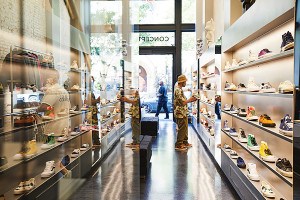Northeastern Honors Alum Ralph Pucci with Mannequin Exhibit

Photo courtesy of Northeastern University
You may not know him by name, but you’ve probably seen his work in a number of department stores. Equal parts businessman and unabashed innovator, he has been defying convention for nearly 39 years by elevating the mannequin to high art. Now, the designs of Ralph Pucci, an NU alum and internationally acclaimed mannequin creator, are the subject of a new exhibit at Northeastern’s Gallery 360 titled “Fashioning Bodies: The Art, Business, and Politics of Mannequins.”
Known for their unique aesthetic and expressions of social commentary, some of Pucci’s most striking pieces reflect a history of changing attitudes about female body image. In today’s climate where thinness—often in extreme and unattainable forms—is considered the paradigm of beauty, Pucci offers structures that illustrate all shapes and sizes of humanity. Featuring forms heavily neglected by the fashion industry, he has created mannequins that are plus-sized, short, curvaceous, disproportionate, and even disabled—as in the case of a wheelchair-bound mannequin used in a 2014 campaign by JCPenney. He has also dealt with issues of race, incorporating a range of ethnically diverse mannequins into his repertoire.

Photo courtesy of Northeastern University
“Pucci’s mannequins are in on the joke of ‘normalcy,’’ says Rachel Rodgers, associate professor of applied psychology at Northeastern. “They help take the fear out of representation.”
With a knack for anticipating and embodying cultural trends, Pucci’s work is also notable as the first of its kind to imitate the body in motion. Launching his career in the midst of the 1976 Olympics, the designer desired to make a form that supported emerging athletic wear. Fast forward 40 years, and his pieces still remain timeless: the running man or yoga-posed female (inspired by iconic model Christy Turlington) could easily be imagined in the storefronts of popular brands like Nike or Lululemon.
However, this consumer accessibility–which makes Pucci’s designs so desirable–is not only achieved through realism. Delving into the world of fantasy, Pucci also collaborated with children’s book author Maira Kalman to create his favorite figure, Ada. Known for its cartoonish features, this quirky mannequin invites customers into an identifiable world of whimsy.

Left: Birdie is roughly a size 16. Right: Ada is one of Pucci’s more playful creations. / Photo courtesy of Northeastern University
Pucci has also worked with a number of other high-profile talents, harnessing the art history knowledge and creative integrity of Patrick Naggar, Lowell Nesbitt, Andrée Putman, Kenny Scharf, Anna Sui, Ruben Toledo, and Veruschka von Lehndorff in order to bring his eclectic designs to life.
The exhibit showcases the production methods behind these collaborations and more about Pucci’s work, through timelapse videos and photography by Antoine Bootz.
Learn the method behind Pucci’s madness, and check out his iconic work, on display at Northeastern’s Gallery 360 until October 23.


